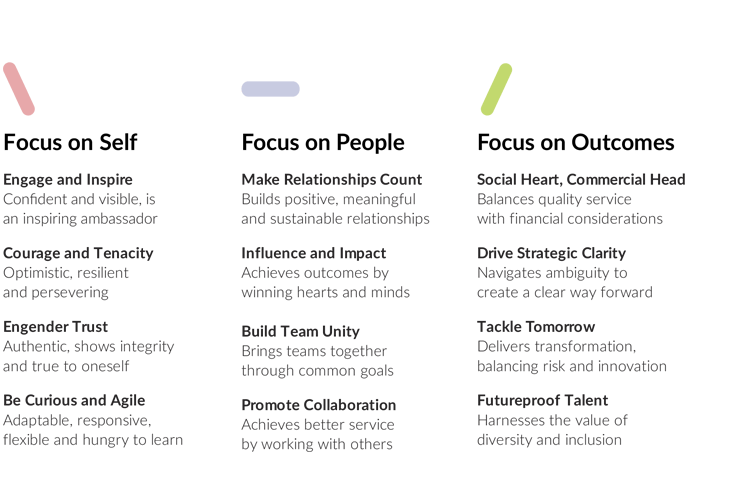As an occupational psychologist, assessing leadership behaviour in the workplace is always high on my agenda. Understanding how leaders are responding to the recent extended period of unforeseen and extreme disruption brings added curiosity and leadership behaviour has become more important than ever at this time, particularly if leaders are to develop organisational recovery strategies. Keen to reference the data we have gathered from profiling 2500 leaders across public services I found myself recently wading through the ‘Journal of Contingencies and Crisis Management’, amongst other publications, to determine whether public service leadership is equipped to lead through extreme disruption.
The two key questions I aimed to tackle were:
1. Which leadership behaviours will most impact performance and accelerate recovery within our public service organisations?
2. What insight can be gained from the GatenbySanderson profiling data with regards leader capability to deliver on these behaviours?
My starting point was to reference GatenbySanderson’s leadership model, Altitude, which benchmarks what behavioural excellence looks like for leaders working across Public and Not for Profit Services. The model can be seen below with the 12 behaviours falling into three clusters; Focus on Self, Focus on People and Focus on Outcomes. We have mapped assessment data on 2,500 leaders to these 12 Altitude behaviours allowing us to benchmark and compare leader capability within or across sectors, be that Local Government, Central Government, Education, Health, Housing, Police and Fire Services, Regulation and Not for Profit. We calculate this variance to generate a benchmark ‘capability measure’. The current leadership context provides a timely opportunity to stress test the model.

While all 12 of these behaviours are key to leadership success, which of them rise to the surface and are crucial when operating under the type of pressure we have seen in recent weeks? There are three behaviours, in particular, most frequently cited for managing through crisis and disruption: Drive Strategic Clarity, Build Team Unity and Engender Trust.
First things first, how do you define a crisis? The definition below certainly aligns to what our partner organisations are currently facing: “a low probability, high impact event that threatens the viability of the organization and is characterized by ambiguity of cause, effect, and means of resolution, as well as by a belief that decisions must be made swiftly” (Pearson & Clair, 1998).
Drive Strategic Clarity
The word ‘belief’ in the definition above suggests that quick decision making is not necessarily something leaders should focus on. Indeed, the authors of a recent Harvard Business Review article ’Are you leading through crisis… or managing the response’ (McNulty and Marcus, March 2020) major on this, suggesting that ‘addressing the urgent needs of the present is the work of management’, with leaders needing to focus on ‘guiding people to the best possible eventual outcome’. Leaders will often focus more immediately on the pressing needs during crisis with the decisions made and actions taken providing a sense of their adding ‘tangible value’. A leader should instead intentionally step back and focus on the long term, broader context, empowering their teams to make tough decisions.
The Altitude Behaviour ‘Drive Strategic Clarity’ aligns with this concept, with leaders navigating ambiguity to provide clear direction.
Our GatenbySanderson capability measure for this behaviour shows this as a top 5 strength for Public Sector leaders, when compared to the other Altitude behaviours. Leaders in Local Government and the Not for Profit sector in particular, demonstrate a significantly higher capability measure for ‘Drive Strategic Clarity’ when compared with the Public Sector baseline. This suggests that leaders in these sectors are more likely to demonstrate the behaviours aligned with focussing on longer term outcomes, rather than immediate response management and are likely to navigate the development of organisational recovery strategies.
Build Team Unity
On a very relevant note, are the leadership lessons learnt following the severe acute respiratory syndrome (SARS) outbreak in 2003 in Singapore. These have been widely published with research largely examining the elements of resilience and leadership in isolation and how this contributed to the rapid containment and successful navigation of the SARS crisis. Teo et al (2017) looked beyond this to consider the role of networks in building resilience within organisations. The role of the leader was deemed critical here in the promotion of ‘relational connections’, encouraging collective ‘meaning-making’ and ‘sense-making’, to activate positive emotions that build organisational resilience and drive performance.
These elements sit at the heart of the Altitude Behaviour ‘Build Team Unity’, defined as bringing teams together through common goals across the organisation.
Insight from our capability measure shows that for Public Sector leaders this behaviour is in the top 5 scoring Altitude behaviours. Leaders working in both the Health sector and Police and Fire service in particular, demonstrate a significantly higher capability measure for ‘Build Team Unity’ compared to the Public Sector baseline. This finding is very positive considering the current crisis with leaders in these sectors more likely to demonstrate the behaviours that will unite their staff towards a common goal and help build organisational resilience.
Engender Trust
The need for leaders to establish trust quickly with new connections, whilst maintaining the trust of employees and pre‐existing connections is a common theme throughout the articles.
Establishing trust during a period of rapid disruption is far harder than having built a foundation for trust ahead of any period of increased uncertainty. A leader who has cultivated a climate of trust will help ensure the commitment of staff as the crisis hits. For new leaders, this is not always possible and trust is not something that can be quickly established. However a recent McKinsey article on responding to the coronavirus outbreak (March 2020) points to specific actions leaders can take to build trust including the ability to show ‘deliberate calm’. This is underpinned by both the demonstration of humility and ‘bounded optimism’ – a combination of realism and confidence, with the latter held in check to prevent a loss of credibility.
The Altitude Behaviour ‘Engender Trust’ captures the essence of the qualities outlined above, with the definition ‘authentic, shows integrity, true to oneself’.
The capability measure for this behaviour for leaders in the Public Sector is ‘mid-range’ when compared to the relative strength of the other Altitude behaviours, however leaders working within the Health sector and Police and Fire score significantly higher for ‘Engender Trust’ when compared with the public sector baseline. This finding suggests leaders in these sectors are more likely to demonstrate behaviours that will maintain commitment from their staff and drive higher performance through crisis than leaders in other sectors.
If you would like a preview of our capability measure insight for your sector against the Altitude model, or to explore how we can partner with you, your team or organisation through the current period of disruption with resilience support please email mark.powell@www.gatenbysanderson.com
Mark Powell, Partner, GatenbySanderson Leadership & Talent Consultancy
